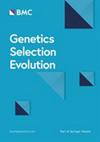蛋鸡育种中不同基因分型及选择策略的分析
IF 3.1
1区 农林科学
Q1 AGRICULTURE, DAIRY & ANIMAL SCIENCE
引用次数: 0
摘要
基因组选择已经成为现代动物育种计划的一个组成部分,有可能通过获得更高的预测精度和缩短世代间隔来提高蛋鸡育种计划的效率,特别是对于雄性,因为它们不能在性别限制的性状(如产蛋性能)上表型化。在本研究中,我们利用MoBPS软件进行随机模拟,研究了不同的策略来减少繁殖方案中两性或仅雄性的世代间隔。此外,还比较了基于不同比例的基因分型、表型和基于家系的选择以及基因组育种值的预测准确性。与仅基于表型的选择相比,基于估计育种价值(无论是基于系谱还是基因组)的母鸡选择增加了遗传增益。利用两个时移亚群体,在亚群体之间交换雄性,减少雄性侧的世代间隔,可显著提高遗传收益。减小雄性和雌性的世代间隔只有在种群规模保持不变的情况下才有效,这导致在同一时间框架内具有基因型和表型的雌性数量比具有较长世代间隔的情况增加一倍。尽管通过以系谱为基础的雌性选择和世代间隔的缩短获得了更高的收益,但这导致了每年近亲繁殖率的大幅提高。在育种价值估计中使用基因组关系矩阵代替基于家系的关系矩阵不仅增加了遗传收益,而且降低了近交率。最优贡献选择的使用导致了与不使用它基本相同的遗传收益,但降低了近交率。然而,与考虑的其他影响所造成的差异相比,最优贡献选择所获得的总体差异很小。利用基因组估计育种值减少雄性侧的世代间隔是非常有益的。只有在高比例的母鸡进行基因分型和增加鸡舍容量的情况下,雌性侧的产蛋期缩短才有益。在蛋鸡育种计划的雌性方面,基于系谱的估计育种值的选择不如表型选择,因为它导致近交率的大幅增加。本文章由计算机程序翻译,如有差异,请以英文原文为准。
Analysis of different genotyping and selection strategies in laying hen breeding programs
Genomic selection has become an integral component of modern animal breeding programs, having the potential to improve the efficiency of layer breeding programs both by obtaining higher prediction accuracies and reducing the generation interval, particularly for males, who cannot be phenotyped for sex-limited traits such as laying performance. In the current study, we investigate different strategies to reduce the generation interval either for both sexes or only for the male side of the breeding scheme based on stochastic simulation using the software MoBPS. Additionally, prediction accuracies based on varying proportions of genotyping and phenotype- and pedigree-based selection as well as genomic breeding values are compared. Selection of hens based on estimated breeding values, either pedigree-based or genomic, increased genetic gain compared to selection based on phenotypes only. The use of two time-shifted subpopulations with exchange of males between subpopulations to reduce the generation interval on the male side led to significantly higher genetic gains. Reducing the generation interval for both males and females was only efficient when population sizes were maintained, which result in doubling of the number of females to genotype and phenotype within the same time frame compared to the scenarios with the longer generation intervals. Although substantially higher gains were obtained by in particular pedigree-based selection of females and a reduction of generation intervals this led to substantially greater rates of inbreeding per year. The use of a genomic relationship matrix in breeding value estimation instead of a pedigree-based relationship matrix not only increased genetic gains but also reduced inbreeding rates. The use of optimum contribution selection led to basically the same genetic gains as without it but reduced inbreeding rates. However, overall differences obtained with optimal contribution selection were small compared to differences caused by the other effects that were considered. The reduction of the generation interval on the male side by the use of genomic estimated breeding values was highly beneficial. Reduction of the generation interval on the female side was only beneficial when a high proportion of hens was genotyped and housing capacities were increased. On the female side of a layer breeding program, selection based on pedigree-based estimated breeding values was inferior to phenotypic selection, as it resulted in a substantial increase in inbreeding rates.
求助全文
通过发布文献求助,成功后即可免费获取论文全文。
去求助
来源期刊

Genetics Selection Evolution
生物-奶制品与动物科学
CiteScore
6.50
自引率
9.80%
发文量
74
审稿时长
1 months
期刊介绍:
Genetics Selection Evolution invites basic, applied and methodological content that will aid the current understanding and the utilization of genetic variability in domestic animal species. Although the focus is on domestic animal species, research on other species is invited if it contributes to the understanding of the use of genetic variability in domestic animals. Genetics Selection Evolution publishes results from all levels of study, from the gene to the quantitative trait, from the individual to the population, the breed or the species. Contributions concerning both the biological approach, from molecular genetics to quantitative genetics, as well as the mathematical approach, from population genetics to statistics, are welcome. Specific areas of interest include but are not limited to: gene and QTL identification, mapping and characterization, analysis of new phenotypes, high-throughput SNP data analysis, functional genomics, cytogenetics, genetic diversity of populations and breeds, genetic evaluation, applied and experimental selection, genomic selection, selection efficiency, and statistical methodology for the genetic analysis of phenotypes with quantitative and mixed inheritance.
 求助内容:
求助内容: 应助结果提醒方式:
应助结果提醒方式:


